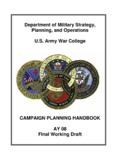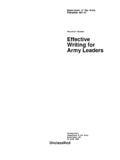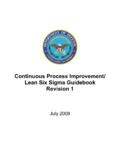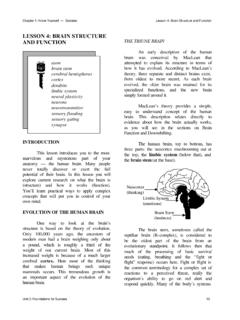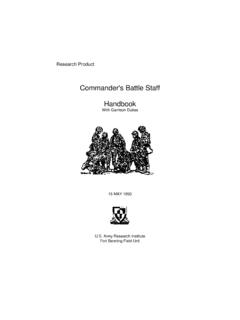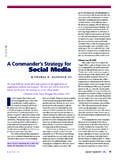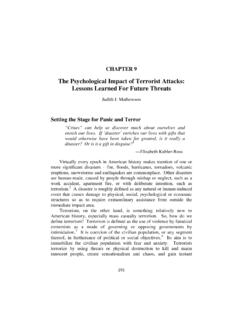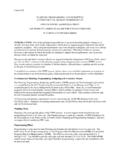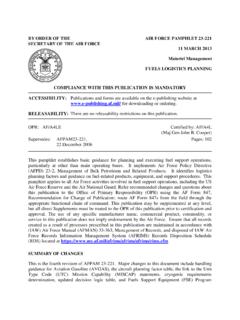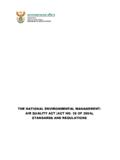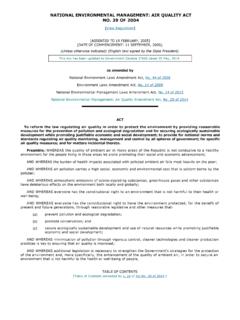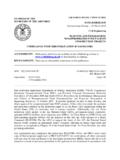Transcription of Combat Leaders Guide
1 ARMY RESEARCH INSTITUTEFORT BENNING FIELD UNITCOMBAT Leaders ' Guide (CLG)2003 LEADER HANDBOOKINTRODUCTIONThe Combat Leaders ' Guide is both anextract of doctrinal publications and acompilation of tactics, techniques andprocedures (TTPs). It is principallydesigned as a pocket reference TTPs you have learned in trainingdo not appear here. The material in thisjob aid comes from the doctrinalliterature pages to be written on; remove,reorganize or tab pages based on yourmission; insert other job aids, TTPs orstanding operating procedures (SOPs)as leading procedure2-1 Warning order (WARNO)2-2 Factors of METT-TC2-3 Estimate of the situation2-8 Operation order (OPORD)2-15 Fragmentary order (FRAGO)2-19 Time schedule2-20 Light and weather data2-21 Leading in combat1-1 Basic rules of combat1-2 Actions before march3-1 Duties of quartering party3-2 March orders3-3 Actions during march3-4 Actions at halts3-5 Actions at assembly area3-6 MOVEBASIC Combat RULES PAGETABLE OF CONTENTS5 DEFENDP reparation for attack4-1 Consolidation4-3 Reorganization4-4 Defensive priority of work5-1 Defense planning outline5-3 Coordination checklist5-5 Establish observation post5-7 Fighting position guidelines5-8 Building fighting position5-9 Range card preparation5-11 Range card (blank)5-13 Range card (sample)
2 5-145-155-175-18 Sector sketch preparationSector sketch (sample)Occupation of a battle positionAT TAC KTABLE OF CONTENTS6 TABLE OF CONTENTSD isengagement planning7-1 Disengagement actions7-2 Passage of lines coordination7-3 Withdrawal under enemy pressure 7-4 Withdrawal not under enemy7-7 pressureRelief in place7-11 DELAYF undamentals of delay6-1 WITHDRAWFire distribution and control5-20 Camouflage5-21 Physical security5-22 Fighting from a battle position5-19 Defending during limited visibility DEFENDPAGE5-247 TABLE OF CONTENTS PATROL/RECONP atrol planning steps8-1 Patrol coordination8-2 Complete the plan8-4 Departure from friendly lines8-6 Rally points8-7 Patrol report (debriefed)8-8 Selection of a patrol base8-9 Occupation of a patrol base8-10 Patrol base activities8-11 Principles of a raid8-12 Conduct a raid8-13 Principles of an ambush8-15 Organize an ambush8-17 Conduct an ambush8-19 Plan a recon mission8-21 Recon zone8-23 Recon area8-25 PAGE8 TABLE OF CONTENTS NBCNBC-1 report9-1 NBC-4 report9-2 NBC-prior to attack9-3 NBC-during attack9-4 NBC-after attack9-6 Unmasking with chemical agent9-8 detector kitUnmask without chemical agent9-9 detector kitMOPP levels9-10 Detailed troop decontamination9-11 MOPP gear exchange9-12 Mark contaminated area.
3 Radio-9-13 logical/biological/chemicalPrepare for NBC attack/protect9-15 against electromagnetic pulseSupervise radiation monitoring9-16 Using a dosimeter9-17 Collect/report total radiation dose9-18 PAGE9 TABLE OF CONTENTSP rinciples of fire support10-1 planning /coordinationCall for fire10-2 Call for fire card10-4 Target list worksheet10-5 Mortar/artillery capabilities10-6 AFV Weapon capabilities10-7 Target acquisition/signature10-8 Attack helicopter capabilities10-9 Artillery counterfire10-10 Supplies and logistical services11-1 Precombat check (mech)11-2 Precombat check (light)11-3 Classes of supply11-4 Integration matrix - Indiv. weapons 11-5 Integration matrix - crew servedweapons11-6 PAGECOMMUNICATIONSFIRE SUPPORT AND OBSERVATIONSUPPLIES/LOGISTICS Electronic counter-counter12-1 measuresRadio troubleshooting12-210 TABLE OF CONTENTSPAGEMINES/DEMOLITIONSM essenger briefing12-3 Phonetic alphabet12-4 COMMUNICATIONSR ules of engagement (ROE)14-1 Area assessment checklist14-2 Checkpoint/roadblock PIR14-4 checklistPEACEKEEPINGI nstall/remove hasty protective13-1 minefieldDA Form 1355-1-R sample13-3DA Form 1355-1-R (blank)
4 13-4 Breaching and clearing minefields13-5 Nonelectric firing system13-6 Nonelectric/electric priming of13-8 demo blockClear nonelectric/electric misfires13-10 Electric firing system13-1111 TABLE OF CONTENTS AIR ASSAULT OPERATIONSA ircraft troop commander briefing15-1 Safety briefing checklist15-2 Reverse planning sequence15-3 Ground tactical plan15-4 considerationsLanding plan considerations15-5 Landing zone selection criteria15-6 Air assault PZ/LZ planning15-7 considerationsExtraction loading plan15-8 requirementsLeader duties in air assault15-9 operationsChalk leader duties/platoon air15-10 assaultSet up a helicopter landing site15-11 Night marking of PZs/LZs15-13 PAGE12 TABLE OF CONTENTS MEDICALE valuate a casualty/first aid16-1 Shock - symptoms/first aid16-2 Heat exhaustion/heat cramps16-3 Heat stroke/sun stroke16-4 Frostbite16-5 Hypothermia/cold weather injury16-6 Request army air MEDEVAC16-7 Continuous operations planning16-8 Heat precautions16-10 Engaging aircraft18-1 Weapons control status18-1 Air defense warning18-2 Local air defense warning18-2 Engagement/lead distances18-3 Passive air defense18-4 Vehicle recovery procedure checklist17-1 Vehicle recovery fundamentals17-2 VEHICLE RECOVERYAIR DEFENSEPAGE13 TABLE OF CONTENTSB uilt-up area fighting principles19-1 Attack and clear a building19-2 Organize building defense19-3 Principles of the Law of War20-1 Handling of enemy prisoners of20-3 war (EPWs)LEGAL ASPECTS OF WARMISCELLANEOUS Spot report/SALUTE21-1 Find unknown range (WORM)21-2 Conversion table.
5 US/metric21-3 Converting azimuths21-4 Reduce risk of fratricide21-5 Risk management21-7 Risk management steps21-10 Risk management matrix21-12 Combat IN CITIESPAGE14 TABLE OF CONTENTSPAGEMISCELLANEOUSP ersonnel records21-13 ACRONYMSA cronyms22-111-11 3 Move to influence the actionMake sound, quick decisionsForcefully execute decisionsUse reverse planning sequenceNotes:Lead from as far forward asyou canLEADING IN COMBATLead from where you cancontrol all elements physicallyor by radio 1 Lead from a position whereyour soldiers can see you/yourvehicle 2 4 5 6 7 8 Set the example11-21 BASIC RULES OF COMBAT1 Use cover and concealmentEstablish local security/reconRULE2 SECUREMOVEE stablish moving element/move to position of advantageGain and maintain initiative3 SHOOTE stablish base of fire/mutualsupportKill/suppress the enemy45 COMMUNICATEI nform all of what you expectSUSTAINKeep fight going/care for troops22-12 3 Make tentative plan 5 Conduct reconnaissance 6 Complete plan 7 Issue orders 8 Supervise and refineNotes.
6 2 Issue warning order (WARNO)TROOP LEADING PROCEDURE 4 Initiate necessary movement 1 Receive mission STEP ACTION22-22 1. Situation _____2. Mission _____3. General Instructions a. Special teams/task organization ___ _____ _____ b. Common uniform/equipment _____ _____ c. Special weapons, ammo, equipment _____ _____ d. Tentative time schedule _____ _____4. Special Instructions _____WARNING ORDER (WARNO)22-32 MISSIONS pecified tasksImplied tasksMission essential tasksLimitations/constraintsRestated missionCommanders' intent 1 and2 levels up1 FACTORS OF METT-TC ITEM FACTORS(FACTORS APPLY TO FR & EN)22-42 FACTORS OF METT-TC ITEM FACTORSENEMYD isposition/compositionRecent activitiesWeaknesses2 StrengthPossible Courses of action(COAs) including identifyingthe most dangerousReinforcement abilitiesProbable COAs includingidentifying the most likely22-52 FACTORS OF METT-TC ITEM FACTORS TERRAIN & WEATHER (OAKOC)
7 3 Observation and fields of fireAvenues of approachKey terrainObstacles and movementCover and concealment4 TROOPS & SUPPORT AVAILABLEQ uality, training level, and psychological state offriendly troopsAvailability of critical systemsand joint supportAvailability of Combat , CS,and CSS assets22-62 FACTORS OF METT-TC ITEM FACTORS TIME AVAILABLE5 Enemy/adversary capabilitiesTime available for planning ,preparing, & executing mission(use 1/3-2/3 rule)Tasks assigned to unitNOTE: planning times includepreparation of Combat orders,inspections, rehearsals, andmovement to line of departure22-72 FACTORS OF METT-TC ITEM FACTORSCIVIL CONSIDERATIONSC ivilian populations, culture,organizations, and leaderswithin area of operations (AO)Civilian activitiesCivilian political, economic,and information mattersNatural environmentCultural sitesCivilian attitudes6 Note:22-821.
8 MISSION ANALYSISa. Mission and intent of commandertwo levels upb. Mission and intent of immediatecommanderg. Tentative time schedulef. Restated missionc. Assigned tasks and purpose (specified and implied tasks)d. Constraints and limitationse. Mission essential tasksESTIMATE OF SITUATION22-92 ESTIMATE OF SITUATION 2. ESTIMATE OF SITUATION AND DETERMINE COURSES OF ACTIOND ispositionCapabilitiesCompositionWeaknes sesRecent Activitiesa. Terrain and weather - effects onpersonnel and equipmentb. Enemy situation and most prob-able course of actionMost probable COA based ondoctrine/situation Terrain - OAKOC Weather - visibility, trafficability, mobility, survivability22-102 ESTIMATE OF SITUATIONc. Friendly situationTask organization to accomplishthe missionNecessary control measuresPurposes and tasks of main andsupporting effortsResults that must be achievedDecisive point and time to focusyour Combat powerd.
9 Friendly COA (repeat for EA COA)Time availableEquipment availableTroops availablee. Prepare a COA statement andsketch22-112 ESTIMATE OF COURSES OF ACTIONb. General factorsCommander's intentRelative effectivenessCharacteristics of offense and defense (as applicable)Weapon utilizationFactors of METT-TCa. Mission-specific factorsMission essential tasksLogistic supportc. Conduct wargame of most likely&most dangerous courses of action22-122 ESTIMATE OF COURSES OFACTION CONSIDERINGHOW WELL THE COA:231a. Supports scheme ofmaneuverb. Helps command & control(C2)c. Concentrates combatpower at the decisive pointd. Has forces providingmutual supporte. Responds to maneuverelements and reservef. Exploits enemy weak-nessesg. Reduces potential impactof adverse weather22-132 ESTIMATE OF COURSES OFACTION CONSIDERINGHOW WELL THE COA:231j.
10 Maximizes observation andranges of weapon systemsi. Provides adequatemaneuver spacek. Provides cover and con-cealmenth. Uses best avenue ofapproachl. Considers obstaclesm. Controls key terrainn. Helps speed of executiono. Does not require adjust-ment of unit positions22-142 ESTIMATE OF COURSES OFACTION CONSIDERINGHOW WELL THE COA:231p. Uses all headquartersq. Reduces, not expands,normal Combat service sup-port (CSS)5. DECISION22-152a. Enemy forces:b. Friendly forces:Operation order (OPORD) - Directiveby commander to his subordinates tocoordinate execution of an in 5 Provides overviewof general situation. Explains whatenemy is doing, what your higherand other friendly units are doing,and what units are attached anddetached to and from your enemy s most likely andmost dangerous courses of Attachments and detachments:OPERATION ORDERa.
